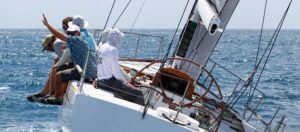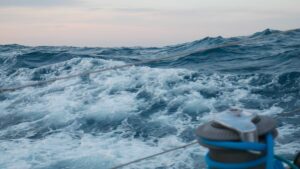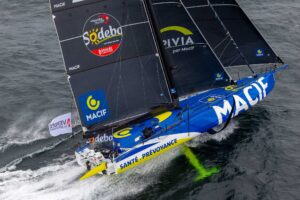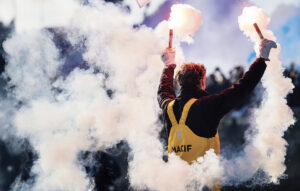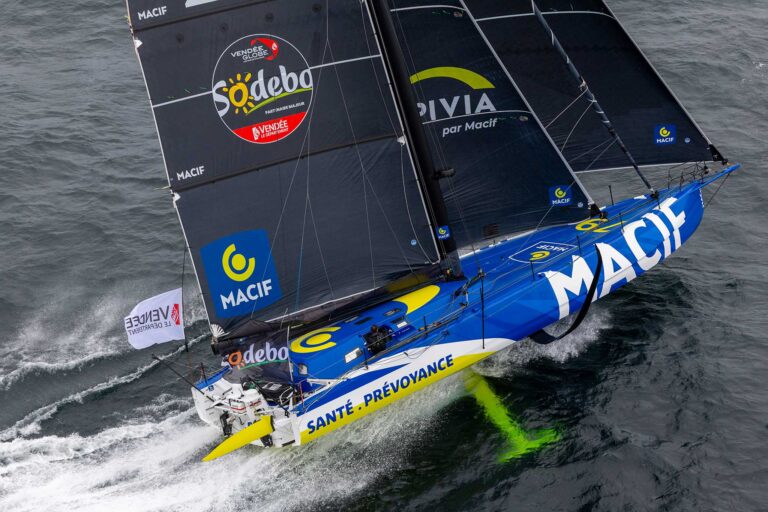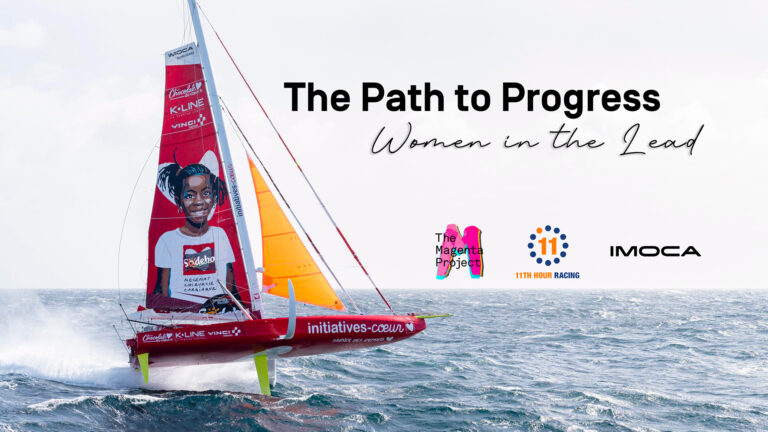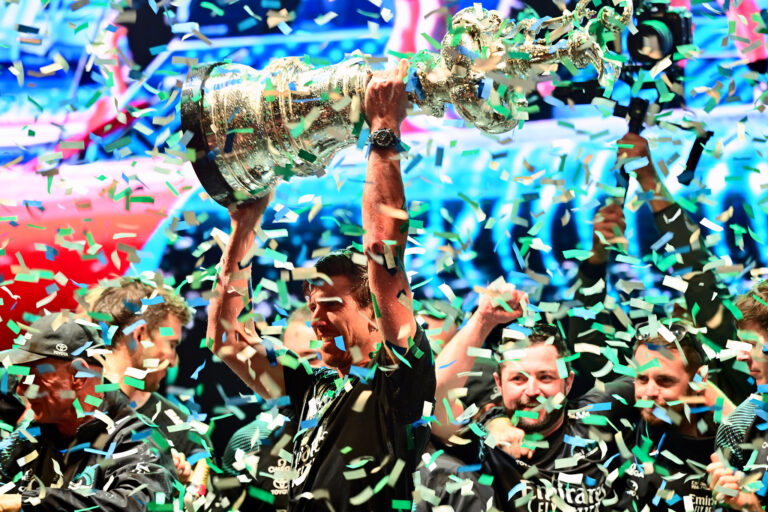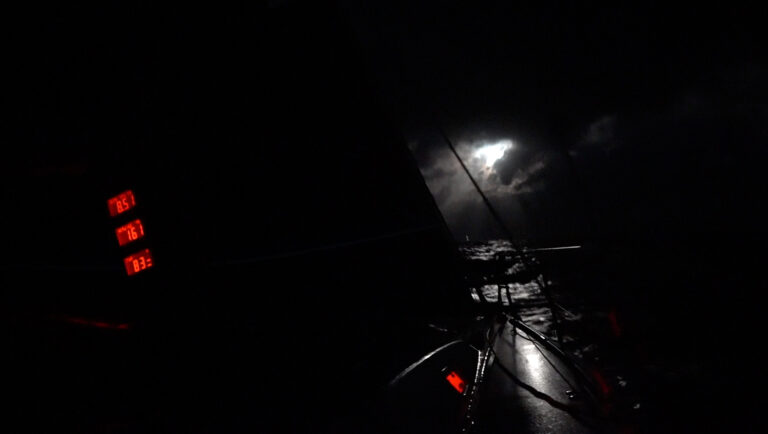
On September 24, 90 singlehanded sailors will take off from Les Sables-d’Olonne, France, racing 21-foot (6.5-meter) Classe Mini boats alone for 4,050 nautical miles to the Canary Islands and then Guadeloupe in the legendary Mini Transat. They sail without chartplotters, laptops, or satellite communications. They race like their lives depend upon it. Renowned for its extreme challenges and the high-performance pocket rockets on which it takes place, the Mini Transat is largely the domain of French singlehanders. This year, though, an American sailor has met the qualifying miles and races necessary to secure a start. Barring unforeseen circumstance, lifelong Annapolis sailor and U.S. Marine Corps veteran Peter Gibbons-Neff will be on the line with his Classe Mini 6.50, Terminal Leave, sailing to meet his own hopes and dreams and to spread the word about an organization that has played a key role in his life, U.S. Patriot Sailing. The following is his story of finding his way to this singular class and his path through thousands of ocean miles he’s had to sail to make it to the starting line.
By the evening of the 12th day at sea in August 2022, I was beyond exhausted. With almost no direct sunlight on my solar panels for the previous week, my boat’s batteries were run down. The final 300 miles into the Bay of Biscay were the most difficult of this 1,300-nautical-mile solo race from the Azores to France. Without power, I had no autopilot, and with my automatic identification system (AIS) transponder shut off, I was playing frogger with giant ships crossing between the mouth of the English Channel and Cape Finisterre, Spain.
Reaching speeds of up to 15 knots, I was surfing down waves with a large asymmetric spinnaker and flying it for days at a time. The two handheld VHF radios were dead, and all that remained was a little handheld GPS and a flashlight to shine on my mainsail. For the first time ever in a race, I hove to that final night at sea for a brief three-hour nap before I hurt myself or the boat.

I was competing in my final qualifying race to earn a place on the starting line of the 2023 Mini Transat, an extreme solo and unassisted race in a 21-foot (6.5-meter) sailboat that happens every other year. The two-stage, 4,000-plus-nautical-mile race departs from the iconic Les Sables-d’Olonne, France, where the Vendée Globe, the ultimate solo nonstop race around the world, begins. The first 1,350-mile leg to the Canary Islands is well known for rough weather and big seas. The second 2,700-mile leg starts in late October with a finish in the Caribbean island of Guadeloupe. This route comprises endless days of reaching in the trade winds—exactly the conditions this type of boat was designed for. To qualify, each participant must compete in sanctioned Classe Mini races for a minimum of 1,500 miles in the boat they plan to race in the Mini Transat. They also need to complete a qualifying course of at least 1,000 miles solo.
How did I get here, an American sailor in this legendary world of French solo ocean racing? I had grown up sailing and racing in Annapolis, Maryland, but that had less to do with how I ended up here than where I had been a few years ago, on active duty as an officer in the Marine Corps. After returning from a deployment, I was going through a divorce and needed a hard reset on my personal life. Professionally everything appeared great, but my free time away from work was difficult.
One cold winter day, I agreed to help the U.S. Patriot Sailing team with boat work on its Farr 30 in Annapolis in preparation for the upcoming season. U.S. Patriot Sailing is a nonprofit that supports veterans navigating the transition to civilian life, rehabilitation after injury, and the complex life challenges associated with combat deployments. It provides camaraderie, a sense of mission accomplishment, and new dynamic experiences through the sport of sailboat racing. With teams based out of Annapolis and Solomons, Maryland, San Diego, California, and most recently Seattle, Washington, it is a national organization that continues to expand its reach. Through a team of dedicated volunteers using donated boats, veterans and active-duty service members are welcomed onto a team. These veterans range from those with no sailing experience to highly proficient racers, and they help each other succeed every day while on the water. Everything is provided at each event, including life jackets, foul weather gear, and instruction.

For me, that first day of frozen fingers working on the Farr turned into two days, and soon I was spending as much time as I could out on the water. The team gave me purpose and a reason to get outside and enjoy life once again. I did not fully realize it at the time, but I needed both the sailing and the teammates in my life.
As I approached 10 years on active duty in the Marine Corps, my final duty station was the Pentagon, and the Annapolis team was there for me throughout my divorce and during my transition into the reserves—two major life changes over the span of two years.
During this time, the world was mostly shut down from the pandemic. One of the first areas of professional sailing to re-emerge was solo ocean racing in France. Skippers training for the Vendée Globe successfully started their race in November 2020. This sparked my initial interest in solo sailing, so I started researching more about it. I found that the Classe Mini was within my financial reach and offered the possibility of competing in the Mini Transat the following year, 2021.
Miraculously, the best-looking Mini for sale in the U.S. happened to be located in Annapolis! It had raced in the Bermuda One-Two twice and was ready to sail. I walked over to a local yacht club to check out the boat, and at first sight, I was committed to solo ocean racing.
In the military we call our final time off “terminal leave.” This leave is used for the concluding time in service where we are paid for those days while not wearing the uniform. It was only fitting to name my boat Terminal Leave since I had about three months of leave saved up, and this would be my transition project off active duty.

The Shakedown Season
After my quick decision to buy the Classe Mini, I spent the fall of 2020 learning how to sail this new-to-me type of boat. My work list included making the boat class-legal and ready to safely race across the Atlantic Ocean. That winter, with the help of friends and U.S. Patriot teammates, I started knocking off to-do list items, such as dropping the rig, rewiring all the electronics, and repairing the boat trailer.
Looking back, it’s easy to forget about all the initial preparations and just focus on the sailing, but this was a crucial and challenging time. Working full time at the Pentagon while completing the requirements to transition off active duty, I was also taking night classes for a master’s degree in strategic intelligence and writing papers—all while trying to start a serious solo ocean racing campaign.
In the spring of 2021, I drove the boat to Baltimore to load onto a car-carrying ship bound for Europe. After months of trying to get a visa, I was finally allowed into France on May 24, 2021, and got to work immediately. La Trinité-sur-Mer would be my home base when not out racing. It is an incredible location, teeming with Class 40s and multiple large 100-foot Ultim trimarans designed to race around the world.
By June I was back offshore for the first time in almost a decade. I grew up racing dinghies and keelboats, including many offshore races and deliveries on my parents’ Farr 395, Upgrade, and skippering the U.S. Naval Academy’s TP52 Invictus in the 2010 Newport-Bermuda Race. With more than 8,000 nautical miles of bluewater experience, I knew I had the foundational skills to safely jump back into offshore sailing.

My first two races that season were doublehanded and took me from the Bay of Biscay through the English Channel to Deauville in Normandy, France. My first solo sail was the delivery from Normandy back to La Trinité-sur-Mer, 360 nautical miles through one of the busiest shipping lanes in the world along with Brittany’s notoriously strong tidal currents. The next race was solo from Port Bourgenay, France, to Getxo, Spain, and back over two stages. The boat was solid, and I continued to learn new things about how to sail it better every day.
This is where I first experienced the raw power of the Bay of Biscay, when, during one race, a deep low-pressure system moved across the area. With almost 40 knots of wind and steep seas in the southern part of the bay, it was an important test. Slammed broadside by one of those seas, I went from sitting in the cockpit to standing on the inside edge of the cockpit and looking over the side as the boat was launched about 90 degrees over. The mast was almost touching the water. I could feel the full force of the wave pushing the entire boat and was worried about rolling over and breaking the rig.
Fear is a natural aspect to solo sailing. It’s not debilitating, but it can wake me up a few minutes early in a 12-minute nap, despite being exhausted, when something does not feel right. I find that in crucial moments, as when that wave pounded my boat, that fear is briefly absent. It might be the kick of adrenaline, but I feel the fear suppressed until everything settles down, and then I realize just how close I am to a new limit in solo ocean racing. Some situations, like getting knocked over, require immediate decision making (like an immediate action drill in the military), while other situations require more contemplation.

By the end of July 2021, and after discussions with sailors and officials in the class, it was clear there was no way for me to qualify in time for that year’s Mini Transat. I shifted my focus to preparing for the 2023 race. Before heading home, I completed my required 1,000-nautical-mile solo sail from Ireland to La Rochelle, France, and back. After 10 days at sea alone and in light air, the final stretch along the Irish coast proved the most challenging.
Wind speeds consistently averaged above 30 knots in a pitch-black night, and steep waves buffeted me from two different directions. A mark of the qualification course was about 2 miles off the Irish coast, and after rounding it, the boat was sailing upwind in an uncomfortable sea state. My greatest concern, as the boat was getting pounded by waves and crashing into the troughs, was the mast breaking. I felt and heard everything in the boat shaking violently through each wave. Earlier I could hear the waves breaking on these fearsome rocks. If I were dismasted close to this lee shore, I would have ended up on the rocky southern coast of Ireland. Transitioning into boat preservation mode, I tacked away and bore off slightly to ride out the weather.
Terminal Leave was bounced around but survived another serious test. I finished the 2021 season having sailed 3,406 nautical miles, including over 2,000 miles solo—a solid basis to build on.

Doubling Down
In April 2022, I returned to La Trinité-sur-Mer for a second season of Mini racing. The objective was to complete my final qualifications for the Mini Transat and improve my performance on the race course. The first race of the season was a 500-mile solo race conveniently starting in La Trinité-sur-Mer. With 100 Minis competing, it was a long starting line. Light winds made it challenging, and the committee shortened the course by almost 90 miles.
My autopilot malfunctioned on the second day, forcing me to hand-steer for the final three days, all while dodging the large fleet of fishing boats operating in the Bay of Biscay. This included sailing through multiple squalls and navigating close to shore.
As we rounded Ile de Ré, an island off La Rochelle, we had to sail through the center span of a bridge. I short-tacked upwind through this narrow channel at night with about 20 other Minis around. We were hit by another squall and lightning was striking close by all round us. Just after passing the bridge, the weather passed through, and patches of fog floated eerily over the water. We sailed single file through this shallow body of water while avoiding large fish and oyster traps.
Toward the end of this multiple-hour sail around the traps, I hit my limit. The severe sleep deprivation led to exhaustion and even hallucinations. I remember seeing strange boats in the night in a glow of red light. While it was probably the headlamp from another competitor sailing by, at the time it looked quite different. As the wind died, I eventually fell asleep. Luckily, the fleet had all stopped in this area, and I did not drift far. At that point I had discovered my limit of sleep deprivation and knew I did not want to reach that point again.
The next race was 220 miles solo out of Douarnenez in northwest France, again shortened due to light winds. This felt more like a sprint and was my best performance of the season. The boat sailed well, and I was able to focus on the tactical situation more than I had in the previous races.
In June, I competed in a 600-miler called the Mini Fastnet, a double-handed race from Douarnenez across the English Channel to the Celtic Sea and back. The fleet was supposed to round the famous Fastnet Rock, but once again light winds forced officials to shorten the course. Short-tacking just a few boat lengths off the rocky shores of Land’s End, England, was slightly terrifying as a boatowner, but worth the risk to avoid the strong currents. After 470 nautical miles of racing, the fleet compressed to just 10 miles as we entered the Bay of Douarnenez. I have yet to see a closer finish in any of the other races. Unfortunately for me, as the wind dropped across the fleet, it filled in sporadically for the final few miles at about 0300. The back half of the fleet ended up passing me as I continued to drift and watch helplessly. It was a frustrating finish to a solid race, but I carried forward the lessons learned.

The final race of the 2022 season was the Les Sables-Azores-Les Sables (SAS), a 2,600-nautical-mile, two-stage solo race with a 60-boat fleet. Departing Les Sables-d’Olonne, we headed southwest 1,300 miles to Horta in the Azores. With its famous high-pressure system sitting over the islands, the fleet struggled over the final half of the course. After 12 days of fierce racing, we only had about three days to rest and recover until we were back on the starting line for the return leg.
As we prepared to depart the Azores, the weather models were not consistent and provided an interesting navigational dilemma: Do you sail a shorter distance closer to the rhumb line but spend more time sailing upwind, or do you sail much farther north and gamble on more favorable reaching conditions?
Unlike most offshore races, racing in the Mini fleet comes with additional challenges: We aren’t permitted any form of satellite communications, so no downloading of weather data. Instead, race organizers broadcast an audio weather forecast once a day (in French and English) over single sideband. We have small SSB radio receivers and tune into this race-specific forecast each afternoon. They provide the general location of pressure systems, fronts, and wind data for large areas of the ocean. We must write everything down, transfer the data onto paper charts, and route ourselves, since we’re also not authorized to use chartplotters or laptops.
As an older Mini Classe boat, Terminal Leave does not have the newer scow bow, so she can’t capitalize as much on heavy-air reaching conditions. So, I chose to sail less distance and stayed just north of the rhumb line. Halfway through the race, the fleet had about a 500-mile lateral spread from the coast of Portugal almost to the coast of Ireland—an unprecedented separation in the race’s history. Since we don’t have internet access to the race-tracking website, the rankings are provided after each forecast. Due to the separation, one day I would be in the top third, followed by the bottom third, then back in the top third the next day. We didn’t know how it would all play out until the final few days of the race.

The downside to my more direct southern route, besides heavy-air upwind conditions, was a lack of sunlight. Solar panels were my only method of charging my batteries, and normally they would be more than sufficient, but the weather would not cooperate. For a week straight I had almost no direct sunlight. With 600 miles left in the race and just enough power to run the autopilot for two hours a day, I thought, “Who would be crazy enough to start a Newport-Bermuda Race with dead batteries?!” But that was equivalent to what I was doing.
By the 10th day, my batteries were completely dead. I hand-steered as much as possible because we were running downwind with the spinnaker up and surfing down waves. Hitting speeds up to 15 knots, these boats are easily overpowered, and lashing down the tiller rarely works in those conditions. We don’t carry wind vane self-steering gear because there is simply not enough room to install it on the boats. It was at this point that I hove to, just to get some rest, before finishing the race with a handheld GPS and a flashlight, dodging numerous ships and small fishing boats moving in all directions.
Terminal Leave and I finished the SAS on August 16 with an elapsed time of just over 24 days. Despite the exhaustion, I was proud to have finished the most difficult race of the Classe Mini that year. Completing this race was the best test of the boat and me for the off year and guaranteed my entry in this year’s race. Over that second season, I sailed more than 4,000 miles, bringing me and Terminal Leave to 7,484 miles, almost 6,000 miles of it solo, since I’d first seen her in Annapolis. Each mile feels much longer on such a small boat. I was proud of this accomplishment.
The Big Show
This year, I returned to France in March and began upgrading and prepping for the biggest test of all in September. Major upgrades have included two new solar panels and adding a hydro-generator. With its small propeller, which I can lower at the stern, the hydro-generator can convert our speed through the water into usable power—no more depending solely on solar. I’ve also replaced some sails, electronics wiring, and running rigging. The combination of wear and saltwater over three seasons really adds up over the miles. Preparations and boat improvements all come down to balancing funding with safety and performance.
My two main goals for the 2023 season have been completing at least one race, as required for the rules, and additional training. (With class participation exploding over the past few years, each race has a cap on participants, and most skippers are only entered in one or two races now due to long waiting lists.)
When I start this Mini Transat in September, my goal will be to complete the race and proudly represent U.S. Patriot Sailing internationally. A top third finish would be ideal, but simply finishing the race will be a massive accomplishment.
The road to the Mini Transat is long and difficult for each skipper. With most campaigns taking three years now to qualify, it requires a significant dedication of time and money to both qualify and cross the finish line. This campaign has come a long way since the first time I saw the Mini in Annapolis and dreamed of racing it across the ocean. It certainly would not be possible without all of the support from friends and family over the past few years, and I’m grateful to everyone who has believed in me, helped work on the boat, and donated to help me get to the starting line.
Peter Gibbons-Neff, Jr., is a lifelong sailor from Villanova, Pennsylvania, who grew up racing in Annapolis, Maryland. After studying oceanography at the U.S. Naval Academy and graduating in 2011, he received his commission as a second lieutenant in the Marine Corps. Peter served on active duty for 10 years as an intelligence officer and is currently a major in the Marine Corps Reserves. In addition to the Mini Transat campaign, volunteering with U.S. Patriot Sailing, and completing his military reserve drill obligation, Peter is finishing a master’s in strategic intelligence at the National Intelligence University in Bethesda, Maryland. He is a member of the Cruising Club of America (CCA), Storm Trysail Club, and the Corinthian Yacht Club of Philadelphia. Peter currently lives in Annapolis. Read about his progress up to now, sign on to support him, and follow his Mini Transat at pgnoceanracing.com. Also, learn more about the work of U.S. Patriot Sailing at uspatriotsailing.org. A version of this story first appeared in the CCA’s annual Voyages magazine in February 2023, and SAIL appreciates the opportunity to reprint it here.
August/September 2023

